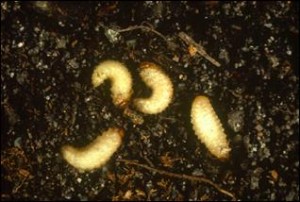Washington State University
Mount Vernon Northwestern Research and Extension Center
Mount Vernon, WA 98273-4768
360-848-6152
Rough strawberry root weevil, Otiorhynchus rugostriatus(Goeze).
 Rough strawberry root weevils (RSRW) were collected from Burlington, WA on ‘Totem’ strawberry on 27 August, 2008. Individual trifoliate leaves were placed in water-filled vials capped with a cotton roll plug. Each treatment consisted of 20 weevils placed on 5 individual leaf arenas held in 5 inch diameter Petri dishes held at room temperature. These leaf arenas were each dipped in respective deionized water-insecticide solutions for approximately 5 sec and air-dried (Table 1). After one day posttreatment, Brigade™ (bifenthrin) and two rates of experimental BAS 320 I provided complete mortality of CCW through contact and ingestion under lab conditions. BAS 320 I represents a new class of chemistry (Group 22) that controls insects by ingestion, blocks the flow of sodium ions and does not require metabolic bio-activation to become insecticidal. RSRW exposed to BAS 320 I were in a moribund state after 1 day posttreatment. Symptoms observed were cessation of feeding, metabolic stress (e.g., diarrhea) and uncoordinated movements that result in prolonged morbidity and death. These post exposure responses were observed for our clay colored root weevil bioassay conducted in June for the same two rates of BAS 320 I. Though the target site of BAS 320 I differs from Bridgade™ (bifenthrin), population mortality upon exposure to bifenthrin often is variably prolonged for 2-3 days as well in adult root weevils. We scored the moribund RSRW’s as dead because they were incapable of pest status and population survival under field conditions given their responses in the laboratory. The insecticidal effect on root weevils is irreversible, as we have observed for the pyrethroids and neonicotinoids, and slower acting compared with the mode of actions of the old carbamate and OP chemistries. BS 320 I is pending registration in blueberry and we will suggest it as an ‘A’ priority next year for strawberry and caneberry IR-4 residue projects.
Rough strawberry root weevils (RSRW) were collected from Burlington, WA on ‘Totem’ strawberry on 27 August, 2008. Individual trifoliate leaves were placed in water-filled vials capped with a cotton roll plug. Each treatment consisted of 20 weevils placed on 5 individual leaf arenas held in 5 inch diameter Petri dishes held at room temperature. These leaf arenas were each dipped in respective deionized water-insecticide solutions for approximately 5 sec and air-dried (Table 1). After one day posttreatment, Brigade™ (bifenthrin) and two rates of experimental BAS 320 I provided complete mortality of CCW through contact and ingestion under lab conditions. BAS 320 I represents a new class of chemistry (Group 22) that controls insects by ingestion, blocks the flow of sodium ions and does not require metabolic bio-activation to become insecticidal. RSRW exposed to BAS 320 I were in a moribund state after 1 day posttreatment. Symptoms observed were cessation of feeding, metabolic stress (e.g., diarrhea) and uncoordinated movements that result in prolonged morbidity and death. These post exposure responses were observed for our clay colored root weevil bioassay conducted in June for the same two rates of BAS 320 I. Though the target site of BAS 320 I differs from Bridgade™ (bifenthrin), population mortality upon exposure to bifenthrin often is variably prolonged for 2-3 days as well in adult root weevils. We scored the moribund RSRW’s as dead because they were incapable of pest status and population survival under field conditions given their responses in the laboratory. The insecticidal effect on root weevils is irreversible, as we have observed for the pyrethroids and neonicotinoids, and slower acting compared with the mode of actions of the old carbamate and OP chemistries. BS 320 I is pending registration in blueberry and we will suggest it as an ‘A’ priority next year for strawberry and caneberry IR-4 residue projects.


| Treatment | lb(AI)/acre | Percent Mortality |
|---|---|---|
| 1DAT | ||
| Mean within columns followed by the same letter are not significantly different (Fisher’s protected LSD, P<0.05), PRC ANOVA SAS. | ||
| BAS 320 I | 0.18 | 100a |
| BAS 320 I | 0.25 | 100a |
| Brigade WSB | 0.10 | 100a |
| Untreated check | 0b | |
Other than spotty clay colored weevil infestations in the north Lynden area, the black vine, strawberry and rough strawberry root weevils were generally economically managed throughout Whatcom and Skagit counties this past red raspberry growing season. These empirical observations suggest the root weevil complex still remains susceptible to Brigade/Capture and Malathion, especially if timed for evening application when the adults are known to be actively feeding during their pre-egg laying period. Growers are learning and feeling more confident with application/timing of the neonicotinoid chemistries registered for foliar control of root weevils in caneberries (i.e., Actara™, Assail™).